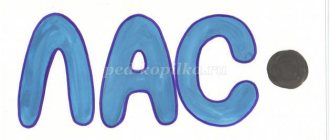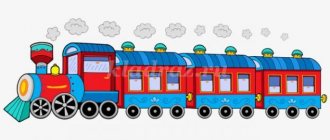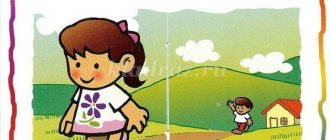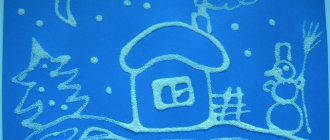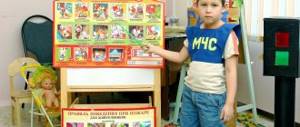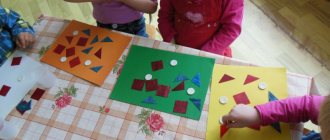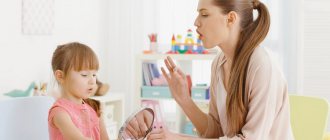Educational lesson based on the fairy tale “Masha and the Bear”
This lesson is intended for children 3-4 years old. Read the fairy tale “Masha and the Bear” with your child. Take the doll Masha, she goes for a walk, picks berries and mushrooms. She came to the forest, and the forest was dense. Tell your child what a dense forest is.
Let's draw a forest.
Together with your child, first draw a sparse forest - the trees are far from each other, then a dense forest - very dense, the trees are close to each other.
Finger game “Fingers in the forest” One, two, three, four, five, the fingers went out for a walk (we show our fists). This finger went into the forest (we bend the fingers one at a time, starting with the little finger), this finger found a mushroom, this one cut it, this one ate it, well, this one just looked! (at the end we tickle your palm)
Game "Find Masha"
Take your picture of a forest (mom can add flowers, mushrooms, Christmas trees). Tell the baby that Masha wants to play hide and seek with him. Invite him to find Masha in the forest and name where she hid - behind a tree, in front of a Christmas tree, to the left of the mushroom, etc.
We make berries.
Then Masha came to the forest. He sees that there are many berries growing on each bush. My child and I make raspberries (we attach a lot of red balls to each other), strawberries (we make a ball, lengthen it on one side, and make dots with a pencil). We make two baskets for Masha. Invite your child to help Masha pick berries - raspberries in one basket and strawberries in the other. We count how many berries are in each basket - where there are more, where there are fewer berries. Make some number cards: put a number in each basket that corresponds to the number of berries in it.
We develop thinking.
Masha walked and walked and saw a house. She went into it. Here you can use pictures for a flannelgraph, theatrical decorations “Home Theater” or simply draw a house. Masha got tired and sat down on a chair. What other furniture do you know? What is a table, chair, bed, etc. for?
Ball game.
Invite your child to remember what happened next. Take the ball and take turns telling a story: one sentence is a child, the other is a mother.
Let's read.
There may be several game options:
- Take cards with a picture of a girl, a bear, trees, mushrooms, a house, etc. Take letter cards. Invite your child to match the letters to the pictures - which ones they begin with.
- Play connecting games with syllables. On the left side of the sheet we draw, for example, Masha. On the right side we write various syllables - ma, yes, sha, va. We pronounce the word slowly. We invite the child to find the syllables that are in this word and cross them out.
Construction.
Invite your child to build a house for the bear. The building material can be anything - a block constructor, counting sticks, cubes, etc. We name the parts of the house - roof, chimney, window. We talk about what kind of houses there are, what material they are built from.
Game "Opposites"
Invite your child to continue the phrase: “The elephant has a big house, but the mouse has ... (small).” “The Christmas tree has prickly needles, but the leaves of the tree... (smooth).”
Mimic gymnastics.
Invite your child to show an angry bear - we raise our eyebrows, a cheerful one - we smile, a surprised one - we raise our eyebrows up. Describe the bear - clumsy, club-footed, heavy. Walk like a bear, waddling from side to side. What's Masha like? Kind, cheerful, friendly, etc.
Outdoor game “At the bear in the forest.”
Choose a bear - let it be mom, for example. The bear sleeps in his “den”. The child walks and pretends that he is picking mushrooms and berries. We say:
I take mushrooms and berries from the bear in the forest, but the bear does not sleep, and looks at us!
After these words, the bear wakes up and tries to catch up with the children. Whoever is caught becomes a bear.
Summary of extracurricular activities, club “On the roads of fairy tales.” Topic: Fairy tale "Masha and the Bear".
Summary of extracurricular activities, club “On the roads of fairy tales.”
Topic: Fairy tale "Masha and the Bear".
Teacher:
Kostina Maria Alexandrovna.
Class
:
1
Target:
creating conditions for the child to express and develop his interests on the basis of free choice, comprehension of spiritual and moral values and cultural traditions.
Tasks:
- To develop the cognitive, creative abilities and emotional-volitional spheres of younger schoolchildren.
- Expand the horizons of students.
- To form students’ desire for personal growth.
| planned results | UUD |
| Personal: develop in students:
Metasubject: develop:
Subject:
|
|
Forms of work:
- collective;
- group.
Preparation for the lesson:
- Materials for the lesson:
- Fairy tale text.
- Tasks for groups.
- Envelopes for geometric shapes.
- Sets of geometric shapes: small and large rectangles, small and large triangles, small and large circles, small and large squares.
- Signs "Rules of behavior in the group."
- Masks and costume attributes.
- Thematic pictures: dishes - frying pan, jug, cup; furniture - sofa, wooden chair and table; equipment - broom, mop, vacuum cleaner.
- Musical fragments: for dance - Dolly the Sheep, for physical exercises the Russian round dance “I’ll go through the raspberries to the garden”, D. Shestakovich “The Tale of the Priest and the Worker Balda” - bear dance.
- Software and hardware:
- Computer at the teacher's workplace.
- Projector.
- Screen.
- Disc with fairy tales.
- CD player
- Preparation of jobs for students:
- Arranging desks into groups.
- Signs with group numbers.
Progress of the lesson
Stage 1. Organizational and motivational
Goal: creating a comfortable environment in the classroom; dividing the class into groups.
Teacher: Hello, children, I invite you to go on a fabulous journey! To do this, you need to dance a magical dance that gives everyone a good mood (music).
DANCE.
Children, smile at each other and give everyone a good mood.
Stage 2. Statement of the problem and search for its solution
Goal: creating a problem situation and finding its solution
| Teacher activities | Student activities |
| Whoever knocks on the door is a fairy tale, believe me, open the door and guess... what kind of fairy tale came to us, brought joy to the children? (Children listen to an audio ) guess its name (answer options). | Children listen to a fairy tale. Determine the name of the fairy tale. |
| Why did you get different answers? I propose to identify the fairy tale based on the illustrations. | Children express their guess. They look at the illustrations and confirm their guess about the name of the fairy tale. |
| Multi-colored flowers appeared in a fairy-tale meadow. Come, choose and find each other! | Children choose flowers (3 colors: red, yellow, blue) and are divided into three groups. |
Stage 3. Organization of creative activities
Goal: creating conditions for organizing creative activities and working in groups.
| Teacher activities | Student activities |
| Creating conditions for organizing creative activities. | |
| We continue to tell the fairy tale... “Masha came to the very wilderness, to the very thicket. He sees a hut in the clearing..." | The children continue to tell the story in chorus. |
| Build a house for the bear from the pieces that are in the envelope on your table. Now I ask each participant in the group to transfer one part of the house to the board so that your building can be seen by guests. Questions for groups: 1 gr. — What geometric shapes did you use to build the house? 2 gr. - Which figures are there more? 3 gr. - Which figures are smaller? — Look at the magic screen Tell me, what could a bear's hut be like? (illustrations: hut - on - chicken legs, village hut, bear hut.) — Why is it important to be able to work in a group? | Children examine the figures and first assemble their part of the house, and then combine it into a common house. We used different geometric shapes: square, rectangle, triangle and circles. More rectangles, because... the house is rectangular in shape. The fewest circles, because it can only be a window in the attic. The children discussed and came to the decision that the bear's house should be: wooden: because standing in the forest; spacious: because the bear is big, that means this is house number 1 — Working in groups is difficult, but interesting; — it’s easy to work in a group, there are more different opinions and answer options. |
| - Let's continue to tell the story... - Remember what Masha saw in the house? Exercise: “ I invite each group to justify their choice. | The children continue to tell the story in chorus: “There is a large stove in the middle, and in the right corner there is a table and a chair. There is a bowl and a pot of milk on the table. The house is clean, in the corner there is a broom made of willow twigs and a rag that makes the floors shine.” Masha saw a table, chairs, pots, a stove, a broom and much more. Group 1. Extra item: iron bowl, because it is iron, and the rest of the dishes are made of clay. Group 2. The extra one is a vacuum cleaner, because... the bear lives in the forest, there is no electricity there. Group 3. The extra one is the sofa, because... the table and chair are made only of wood, they are talked about in the fairy tale, the sofa is not mentioned in the fairy tale, but it is also made of wood. |
| Brief analysis of the characters of the fairy tale | |
| And then what happened... - What Masha was like, what the bear was like. Describe their characters. | The children continue to tell the fairy tale in chorus: “The bear did not let the girl go and Masha remained to live with him.” Masha was cheerful, but the bear was sad, he had no friends. Masha was irresponsible, left her friends, and the bear was looking for a friend. |
| Fizminutka (dances of Masha and the bear) I propose to show Masha and the bear in dance. | First, the girls dance to the Russian round dance, and then the boys dance like bears. |
| I propose that each group act out their own excerpt from the fairy tale, which is in envelope No. 3. We will be helped by adults - our guests (Each director has a plan according to which he acts.) Remember, you need to read the passage and choose Masha and the bear, and perhaps choose other actors for other roles. The audience's task is to watch and listen carefully. Be grateful spectators. | "Theater" 1 group: She thought and thought and came up with an idea. One day a bear comes from the forest, and Mashenka says to him:
And that’s exactly what Mashenka needs! She baked pies, took out a big, big box and said to the bear:
2nd group: Mashenka says:
As soon as the bear came out onto the porch, Mashenka immediately climbed into the box and placed a plate of pies on her head. The bear returned and saw that the box was ready. He put him on his back and went to the village. A bear walks between fir trees, a bear wanders between birch trees, goes down into ravines, and up hills. He walked and walked, got tired and said: I’ll sit on a tree stump and eat a pie! And Mashenka from the box: I see, I see! Don't sit on the tree stump, don't eat the pie! Bring it to grandma, bring it to grandpa!
He picked up the box and moved on. He walked and walked, walked and walked, stopped, sat down and said: I’ll sit on a tree stump and eat a pie! And Mashenka from the box again: I see, I see! Don't sit on the tree stump, don't eat the pie! Bring it to grandma, bring it to grandpa! The bear was surprised:
He got up and walked quickly. 3rd group: I came to the village, found the house where my grandparents lived, and let’s knock on the gate with all our might: Open the doors, I brought you a gift from Mashenka. And the dogs saw the bear and began to bark and rush at the bear. The bear threw the box and set off without looking back. Grandma and Grandpa came out to the gate. They see the box standing, the lid has been lifted, and there sits Mashenka, alive and healthy. |
Stage 5. Analysis and summary
Purpose:
to analyze the knowledge gained during the lesson; summarize the lesson.
| Teacher activities | Student activities |
| -What fairy tale did we remember? | — We remembered the Russian folk tale “Masha and the Bear.” |
| -What did you study? | - Today we learned to compare objects (according to their significance for the hero of a fairy tale - a bear), choose the odd one out, dramatize a fairy tale, dance like the heroes of a fairy tale, etc. |
Stage 6. Reflection
Purpose: to track the level of satisfaction with the lesson.
| Teacher activities | Student activities |
| - Determine your mood. Flowers bloomed in a fairy-tale meadow: Red - great mood, I did well in class, green flower - good mood, but it was difficult for me to complete the task, blue flower - my mood is sad because some tasks seemed difficult to me. | — Children choose flowers and attach them to the clearing. — Children perform a mood analysis after class. |
Explanatory note for the lesson on extracurricular activities in 1st grade
“Through the pages of the Russian folk tale “Masha and the Bear”
“The only path leading to knowledge is action”
B. Shaw
In the concept of the Federal State Educational Standard, as the final result of the educational activities of a Russian school, a portrait of a primary school graduate is recorded, in which the main place is given to the creative qualities of the child: “... Curious, interested, actively exploring the world; able to learn, capable of organizing his own activities..."
Purpose of extracurricular activities
: creating conditions for the child to express and develop his interests on the basis of free choice, comprehension of spiritual and moral values and cultural traditions.
The lesson on the topic “Through the pages of the Russian folk tale “Masha and the Bear” is integrated. Implemented in the direction of “General Intellectual”. The course for the development of cognitive abilities was developed by L.V. Meshchenkova. in order to create conditions for the child to express and develop his interests on the basis of free choice, comprehension of spiritual and moral values and cultural traditions. It contains tasks from various fields of knowledge: Russian language, literature, mathematics, the surrounding world. The lesson, held in a playful way, contributes to the relaxed correction and development of students’ mental qualities, the formation of general intellectual skills, broadening their horizons, developing cognitive abilities and, ultimately, achieving high-quality results in their studies.
Activities in the lesson are aimed at achieving the results of the Federal State Educational Standard:
- Expansion of moral and ethical concepts: “good”, “mutual assistance”, “respect” through Russian folklore;
- ability to manage one’s activities;
- ability to exercise control and correction;
- ability to work with information;
- communicative competence in communication and cooperation with peers;
- ability to use theatrical techniques;
- manipulations with geometric shapes;
- enrichment of students’ active and passive vocabulary: “pot”, “little jar”, “hut”, “fence”, “box”;
- practicing reading skills: comprehension, intonation, listening.
Activities in the lesson are aimed at developing the following UUD:
- the ability to correlate the actions of literary characters with generally accepted ethical moral standards.
- search for information;
- the ability to express one's thoughts;
- goal setting - as setting an educational task based on the correlation of what is already known and learned by the student and what is still unknown;
- self-regulation as the ability to mobilize strength and energy;
- planning collaboration in a group;
- developing the ability to apply the studied material to solve a practical problem.
- modeling using geometric shapes;
- establishing cause-and-effect relationships;
The goal is achieved step by step in accordance with the structure of the lesson.
The lesson presents 3 types of motivation: cognitive, communicative, success motivation, which forms a positive attitude and motivation to study the spiritual and moral heritage.
This lesson was developed and conducted in 1st grade.
A characteristic feature of this age is curiosity, an inquisitive mind, a desire for knowledge and information, the manifestation of spiritual qualities and characteristic personality traits of the student.
The use of a systemic activity method and collective creative learning at this age is important for adaptation, getting to know the team and demonstrating individuality.
The joint activity of students and teachers in extracurricular activities has a great influence on the educational process, changes the system of relationships, and allows them to show cognitive interest in activities based on respect, cooperation, and independent critical thinking.
During the lesson, materials were used from the correctional and developmental course “RPS” for a public school by L.V. Meshchenkov. "36 lessons for excellent students."
The relevance of this lesson lies in the student’s manifestation of his interests on the basis of free choice, comprehension of spiritual and moral values and cultural traditions.
During the lesson, various forms of organizing activities are used (collective, individual, pairs, frontal).
During the lesson, the individual characteristics of the group were taken into account: not all students can work quickly, some children find it difficult to concentrate when necessary, not all have stable attention, which corresponds to the psychological characteristics of this age.
So I designed using:
— TSO (computer with a projector) for a more vivid presentation of lesson materials, to implement a person-centered approach, to achieve the goal of the lesson;
— supporting and didactic material of a text nature to improve the quality of memorization and performance in the classroom.
At the stage of organizing creative activity, the methodology of problem-dialogical teaching was used.
The transition from collaborative learning activities to independent ones lies in the elements of problem conversations: why? How? and argumentation of statements.
Throughout the lesson, methods and techniques familiar to students in educational activities were used: put forward a hypothesis, prove it, create a product of joint creative activity, formulate your answer.
At the reflection stage, the “Mood Screen” method is used, students express their opinions and analyze the complexity of the lesson. Reflection plays a big role in the formation of students’ self-esteem, which is one of the most important stages of the lesson, because it is aimed at developing the student’s initiative. Much attention is paid to it in the system of developmental education.
In this lesson, sufficient attention was paid to the principle of “psychological comfort”. During the lesson, I created a situation to create motivation for success in the form of accepting any answer (everyone has the right to their own point of view).
In my activities I pay great attention to health, so during the lesson I used folk music for physical education.
5
Thematic lesson “Masha and the Bear” (from Tatyana)
A new year has begun, new games and activities. I want to show you the last of three thematic lessons that Tatyana and Taechka sent about bears. The first was informational about bears, the second was about the fairy tale “Three Bears” and the last one was about Dasha’s beloved fairy tale “Masha and the Bear”. She loves this cartoon and fairy tale so much that we even threw her a themed birthday party. And now attention to the “screen”
